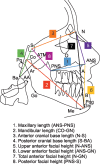Cephalometric Assessment of Dentoskeletal Characteristics in Children with Digit-sucking Habit
- PMID: 32904107
- PMCID: PMC7450188
- DOI: 10.5005/jp-journals-10005-1761
Cephalometric Assessment of Dentoskeletal Characteristics in Children with Digit-sucking Habit
Abstract
Background: Nonnutritive sucking can turn into a continuous behavior practiced unconsciously, leading to a deleterious oral habit. Digit-sucking habits are an important etiological factor for malocclusion.
Aim: To investigate the effect of the digit-sucking habit on dentofacial structures by employing a cephalometric analysis.
Materials and methods: Selected 120 children were grouped as 60 with the digit-sucking habit and 60 without the digit-sucking habit in the age ranging between 6 and 12 years without gender discrimination. All were subjected to the standardized cephalometric technique, radiographs were traced by a single operator on a standard matte acetate tracing paper in a darkened room, and a total of 8 linear and 11 angular variables were measured for each patient in both the groups.
Statistical analysis: The unpaired Student's t-test was used to compare the mean difference between the two groups.
Results: The digit-sucking group showed significant difference in linear skeletal measurements such as value from anterior nasal spine (ANS) to posterior nasal spine (PNS), condylon to gnathion, nasion to ANS, sella to basion, and angular measurements such as angle between maxillary incisor to cranial plane, mandibular incisors to mandibular plane, sella nasion to point A, sella nasion to point B, and mandibular plane to cranial plane, when compared to the control group.
Conclusion: Within the confined parameters, digit sucking has led to significant variations in certain dental and skeletal cephalometric measurements.
How to cite this article: Singh TS, Sridevi E, Sai Sankar AJ, et al. Cephalometric Assessment of Dentoskeletal Characteristics in Children with Digit-sucking Habit. Int J Clin Pediatr Dent 2020;13(3):221-224.
Keywords: Digit sucking; Lateral cephalometry; Malocclusion.
Copyright © 2020; Jaypee Brothers Medical Publishers (P) Ltd.
Conflict of interest statement
Source of support: Nil Conflict of interest: None
Figures
References
-
- Tulley WJ. Adverse muscle forces - their diagnostic significance. Am J Orthod. 1956;42(11):801–814. doi: 10.1016/0002-9416(56)90088-4. DOI: - DOI
-
- Sim MJ, Finn SB. Oral habits in children. In: Finn SB., editor. Clinical Pedodontics. 4th ed., Philadelphia: W.B. Saunders Company; 1987. pp. 323–390.
-
- Khijmatgar S, Badavannavar A, Saraiya S. Digit sucking as an etiological factor for skeletal discrepancies: a review. Unique J Med Dent Sci. 2015;3:63–67.
LinkOut - more resources
Full Text Sources



